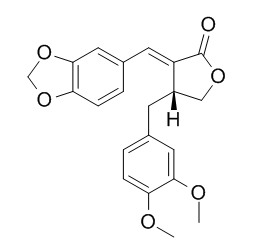Suchilactone
Suchilactone may have the potential to be developed as a treatment of Alzheimer's Disease.
Inquire / Order:
manager@chemfaces.com
Technical Inquiries:
service@chemfaces.com
Tel:
+86-27-84237783
Fax:
+86-27-84254680
Address:
1 Building, No. 83, CheCheng Rd., Wuhan Economic and Technological Development Zone, Wuhan, Hubei 430056, PRC
Providing storage is as stated on the product vial and the vial is kept tightly sealed, the product can be stored for up to
24 months(2-8C).
Wherever possible, you should prepare and use solutions on the same day. However, if you need to make up stock solutions in advance, we recommend that you store the solution as aliquots in tightly sealed vials at -20C. Generally, these will be useable for up to two weeks. Before use, and prior to opening the vial we recommend that you allow your product to equilibrate to room temperature for at least 1 hour.
Need more advice on solubility, usage and handling? Please email to: service@chemfaces.com
The packaging of the product may have turned upside down during transportation, resulting in the natural compounds adhering to the neck or cap of the vial. take the vial out of its packaging and gently shake to let the compounds fall to the bottom of the vial. for liquid products, centrifuge at 200-500 RPM to gather the liquid at the bottom of the vial. try to avoid loss or contamination during handling.
Evid Based Complement Alternat Med.2018, 2018:8565132
Pharmacogn Mag.2015, 11(43):562-6
Chem Biol Interact.2016, 258:59-68
Regul Toxicol Pharmacol.2024, 149:105620.
VNU J of Science: Med.&Pharm. Sci.2023, 39(1):20-29.
Biomolecules2021, 11(10),1513.
Antiviral Res.2021, 193:105142.
Int J Mol Sci.2024, 25(15):8101.
Drug Dev Ind Pharm.2024, 50(11):938-951.
Planta Med.2019, 85(3):217-224
Related and Featured Products
J Agric Food Chem. 2017 Apr 19;65(15):3133-3140.
Protective Roles of Monsonia angustifolia and Its Active Compounds in Experimental Models of Alzheimer's Disease.[Pubmed:
28378593 ]
Alzheimer's disease (AD), a progressive neurodegenerative disorder, is characterized by the accumulation of neurotoxic β-amyloid (Aβ) peptides, which consequently affects cognitive decline and memory impairment. Current research on AD treatment is actively focusing on the prevention of neurotoxic Aβ peptide accumulation. Monsonia angustifolia is reported to be consumed as an indigenous vegetable in Tanzania.
METHODS AND RESULTS:
In this study, we investigated the effect of the ethanol (EtOH) extract of M. angustifolia dried ground material on Aβ production and spatial learning ability as protection against AD. The formation of Aβ peptides was significantly reduced in HeLa cells stably transfected with the Swedish mutant form of β-amyloid precursor protein (APPsw) after treatment with a 60% EtOH extract of M. angustifolia. We next examined the cognitive-improving effects of the EtOH extract in vivo. Tg2576 mice were treated with extract for 6 months and subjected to Morris water maze and novel object recognition tests. The results showed that the 60% EtOH extract of M. angustifolia significantly ameliorated behavioral deficits of the AD transgenic mice and reduced the level of insoluble Aβ42 in the cerebral cortex and hippocampus. We further found that the 60% EtOH extract was effective for memory function recovery after shorter treatment (4 months). In addition, we isolated and identified several single compounds, justicidin A, 5-methoxyjusticidin A, chinensinaphthol, retrochinensinaphthol methyl ether, and Suchilactone, from M. angustifolia and tested these compounds.
CONCLUSIONS:
Among them, justicidin A potently decreased the formation of Aβ in APPsw-transfected cells. These data suggest that the 60% EtOH extract of M. angustifolia has the potential to be developed as a treatment of AD. Furthermore, justicidin A may contribute, at least partially, to the Aβ alteration observed with the extract treatment.



